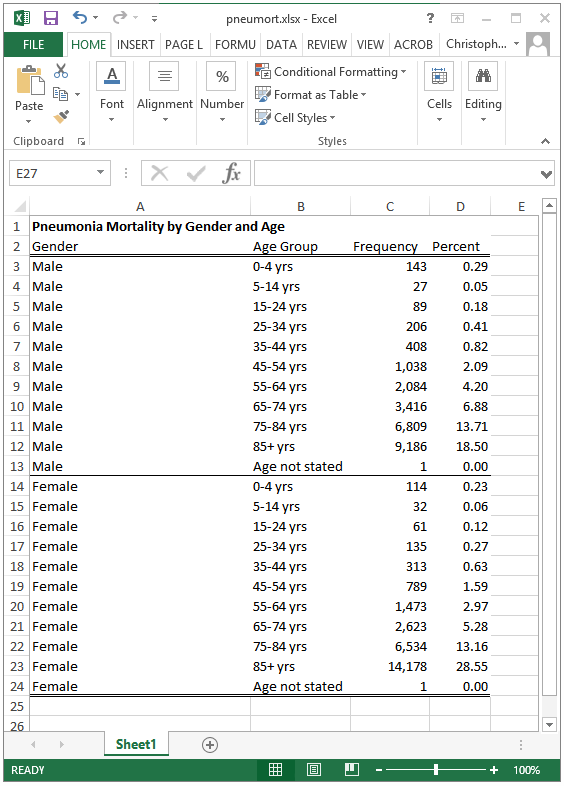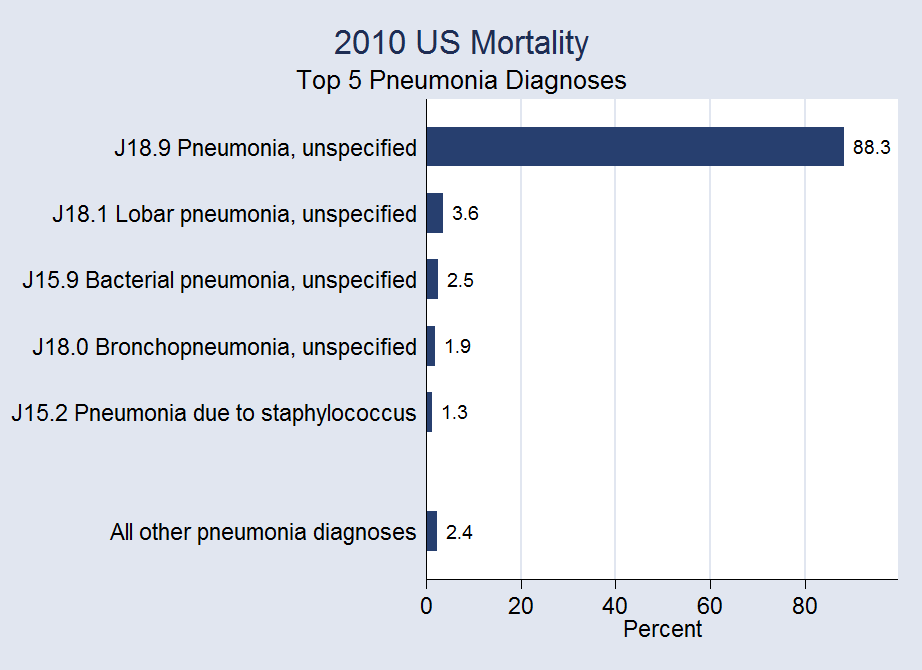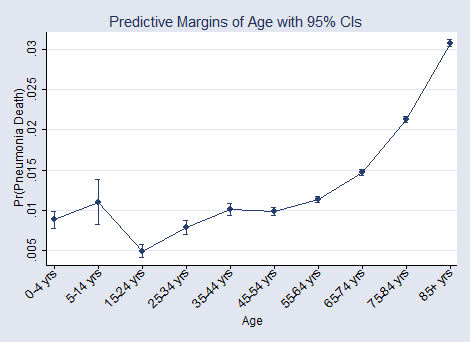How to Read in Mortality Data From Nhanes Using Stata
What's this about?
ICD-10 codes are the standard for reporting international morbidity and bloodshed figures. They are also used by many countries to lawmaking diagnosis information for healthcare encounters such equally a visit to a doctor or an admission to the hospital. The codes tin can be institute in many authoritative datasets such as death certificates, hospital discharge records, and medical billing forms.
When data are gathered from multiple sources, they may non be fully standardized. There can also be reporting errors. icd10 is designed to address these common challenges with secondary data. Finally, the number of codes means that analyzing the information in a meaningful fashion is often impossible without summarizing the data. Whether you want to add text to codes or create indicator variables, icd10 makes working with ICD-ten diagnosis codes easy.
Let's come across it work
Nosotros take 2010 mortality data for the United States—more than than ii.4 million deaths.
. use female agerc cause place using vital10.dta, clear (United states bloodshed data, 2010 -- CDC Vital Statistics) . depict Contains data from vital10.dta obs: two,472,542 US mortality information, 2010 -- CDC Vital Statistics vars: 4 31 Mar 2015 thirteen:46 size: 32,143,046
| storage brandish value | ||
| variable name type format label variable label | ||
| female person float %ix.0g female Decedent is female, female=ane, | ||
| male=0 | ||
| identify byte %viii.0g pod Identify of decease and status | ||
| crusade str4 %9s Cause of death (ICD-ten code) | ||
| agerc bladder %fourteen.0g agerc Historic period, Census recode | ||
| Sorted past: | ||
We desire to identify all deaths due to respiratory illnesses. Whatsoever of 275 codes tin currently be used to define a respiratory illness, far more than we would e'er want to type! A plausible alternative is to utilize a lookup table, but definitions are oft provided in terms of a range of codes, leaving you to type the codes at least once to create the lookup table anyway.
icd10 provides a straightforward and fast alternative. All respiratory diagnoses fall in the range of J10 to J98.9, and so the but matter we demand to do is blazon
. icd10 generate resp = cause, range(J10/J989)
You practice not demand to provide split up ranges for category (three-grapheme) and subcategory (4-character) codes because the range() choice of icd10 treats category codes as the everyman value in a range.
We may wish to further examine deaths from pneumonia. We want to add together an indicator for a pneumonia cause of expiry to only those decedents that we already know have a respiratory diagnosis.
. icd10 gen pneumonia = cause if resp==1, range(J12/J189) . tabulate pneumonia
| pneumonia | Freq. Per centum Cum. | |
| 0 | 187,594 79.07 79.07 | |
| 1 | 49,660 xx.93 100.00 | |
| Total | 237,254 100.00 |
We see that about 21% of all deaths from respiratory illnesses in the Us in 2010 were from pneumonia.
Of course, we can use icd10 for many other tasks, such every bit checking that codes are defined, adding WHO's official descriptions of the codes to our dataset, standardizing formats, and more than.
For at present, though, let's look at a few of the many cases when information management with icd10 is useful.
It is useful if y'all need to identify populations with diseases or causes of deaths for reports. For instance, nosotros could create a summary dataset and and so export it using consign excel:

We have further customized the format of this tabular array using Excel prison cell formatting.
Information technology is useful if you want to create nicely labeled frequency plots. Using icd10 generate with the description and long options combined with Stata'south commands to create and graph summary data, nosotros can create graphs such as

It is useful if you are calculating basic epidemiological statistics. For instance, we could create a summary dataset and add together population information to calculate the number of deaths due to pneumonia by age and sex and then compare age-standardized rates by sexual activity.
. contract female person agerc if pneumonia==1, freq(pneudeaths) . depict using as2010, brusk Contains data Demography 2010 population (by age and sex) (output omitted) . describe using 2010, curt Contains data Census 2010 population by age (output omitted) . merge i:i female agerc using as2010, nogenerate (output omitted) . dstdize pneudeaths pop agerc, by(female person) using(2010) (2 observations excluded considering of missing values)
| -> female= 0 | ||
| -----Unadjusted----- Std. | ||
| Pop. Stratum Pop. | ||
| Stratum Pop. Cases Dist. Rate[due south] Dst[P] s*P | ||
| 0-4 yrs 10319427 143 0.068 0.0000 0.065 0.0000 | ||
| 5-fourteen yrs 20969500 27 0.138 0.0000 0.133 0.0000 | ||
| 15-24 yr 22317842 89 0.147 0.0000 0.141 0.0000 | ||
| 25-34 yr 20632091 206 0.136 0.0000 0.133 0.0000 | ||
| 35-44 yr 20435999 408 0.135 0.0000 0.133 0.0000 | ||
| 45-54 yr 22142359 1038 0.146 0.0000 0.146 0.0000 | ||
| 55-64 year 17601148 2084 0.116 0.0001 0.118 0.0000 | ||
| 65-74 year 10096519 3416 0.067 0.0003 0.070 0.0000 | ||
| 75-84 yr 5476762 6809 0.036 0.0012 0.042 0.0001 | ||
| 85+ yrs 1789679 9186 0.012 0.0051 0.018 0.0001 | ||
| Totals: 151781326 23406 Adjusted Cases: 29474.vii | ||
| Crude Charge per unit: 0.0002 | ||
| Adapted Charge per unit: 0.0002 | ||
| 95% Conf. Interval: [0.0002, 0.0002] | ||
| -> female= 1 | ||
| -----Unadjusted----- Std. | ||
| Popular. Stratum Pop. | ||
| Stratum Pop. Cases Dist. Charge per unit[s] Dst[P] s*P | ||
| 0-four yrs 9881935 114 0.063 0.0000 0.065 0.0000 | ||
| five-14 yrs 20056351 32 0.128 0.0000 0.133 0.0000 | ||
| 15-24 twelvemonth 21308500 61 0.136 0.0000 0.141 0.0000 | ||
| 25-34 yr 20431857 135 0.130 0.0000 0.133 0.0000 | ||
| 35-44 year 20634607 313 0.131 0.0000 0.133 0.0000 | ||
| 45-54 yr 22864357 789 0.146 0.0000 0.146 0.0000 | ||
| 55-64 yr 18881581 1473 0.120 0.0001 0.118 0.0000 | ||
| 65-74 yr 11616910 2623 0.074 0.0002 0.070 0.0000 | ||
| 75-84 yr 7584360 6534 0.048 0.0009 0.042 0.0000 | ||
| 85+ yrs 3703754 14178 0.024 0.0038 0.018 0.0001 | ||
| Totals: 156964212 26252 Adjusted Cases: 21813.eight | ||
| Rough Rate: 0.0002 | ||
| Adjusted Rate: 0.0001 | ||
| 95% Conf. Interval: [0.0001, 0.0001] | ||
| Summary of Written report Populations: | ||
| female Northward Rough Adj_Rate Confidence Interval | ||
| 0 151781326 0.000154 0.000194 [ 0.000192, 0.000197] | ||
| one 156964212 0.000167 0.000139 [ 0.000137, 0.000141] |
Finally, it is useful if you lot want to create an indicator variable for analysis. For example, we may want to summate and plot the marginal effect of age group on the probability of pneumonia every bit the cause of decease, after controlling for whether the decedent is female.
. logit pneumonia i.female person i.agerc (output omitted) . quietly margins agerc . marginsplot, title("Predictive Margins of Age with 95% CIs") xtitle(Age) xlabel(, angle(45)) ytitle("Pr(Pneumonia Death)") 
In brusque, whether you just desire to verify that your data are valid or are using the codes as a pace in a larger project, icd10 provides valuable tools for reporting and inquiry.
The ICD-10 codes used in Stata are copyrighted to WHO. To run across data about the copyright and updates to the codes, type
. icd10 query ICD-x Version and Change Log License agreement ICD-10 codes used past permission of the World Health Organization (WHO), from: International Statistical Classification of Diseases and Related Health Problems, Tenth Revision (ICD-ten) 2010 Edition. Vols. one-3. Geneva, World Wellness System, 2011. See copyright icd10 for the ICD-10 copyright notification. Edition 2010, 2015 update Per the license agreement with WHO, "Official WHO Updates combined 1996-2012 Volume 1" was reviewed for potential changes scheduled for implementation on January 1, 2015. Between 2014 and 2015: 0 codes added, 0 codes deleted, 0 code descriptions changed. (output omitted)
Tell me more
You can read more than about ICD coding, including tips for working with records with multiple diagnosis codes, in [D] icd and more nearly icd10 in [D] icd10.
The icd9 and icd9p commands for ICD-ix-CM diagnosis and procedure codes accept likewise been improved. Run across [D] icd9.
For more about the other commands used above, see
- tabulate: One-fashion tabulations of variables
- contract: Make a dataset of summary statistics
- export excel: Consign data to Excel or other spreadsheet programs
- putexcel: Export results to Excel and format Excel data
- graph hbar: Horizontal bar charts
- dstdize: Directly standardization of rates
- logit: Logistic regression analysis
- margins: Calculate marginal furnishings
- marginsplot: Plot marginal furnishings
Upgrade at present Order Stata
Source: https://www.stata.com/stata14/icd-10/
0 Response to "How to Read in Mortality Data From Nhanes Using Stata"
Post a Comment